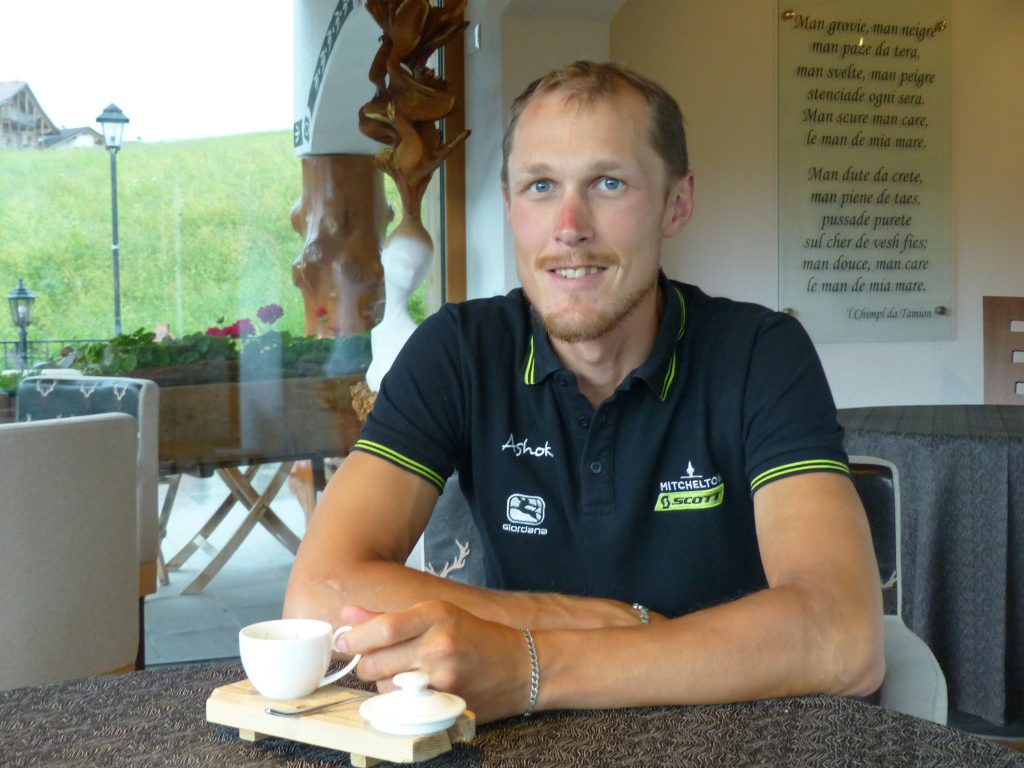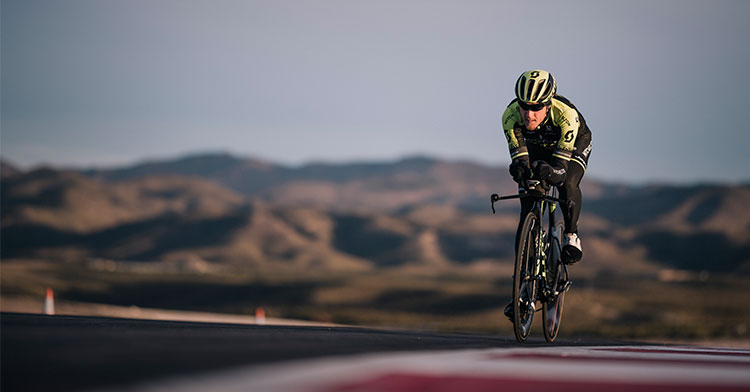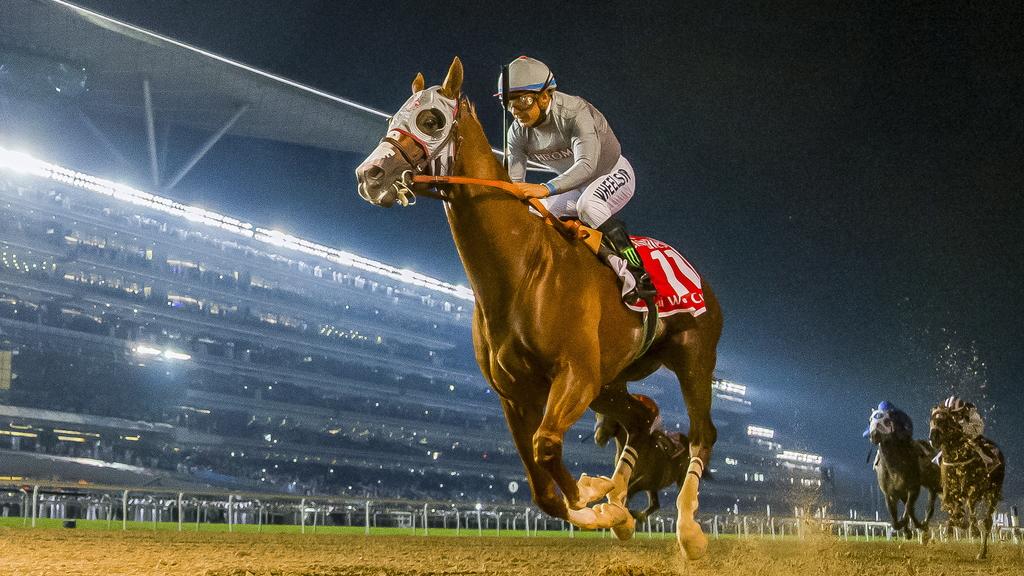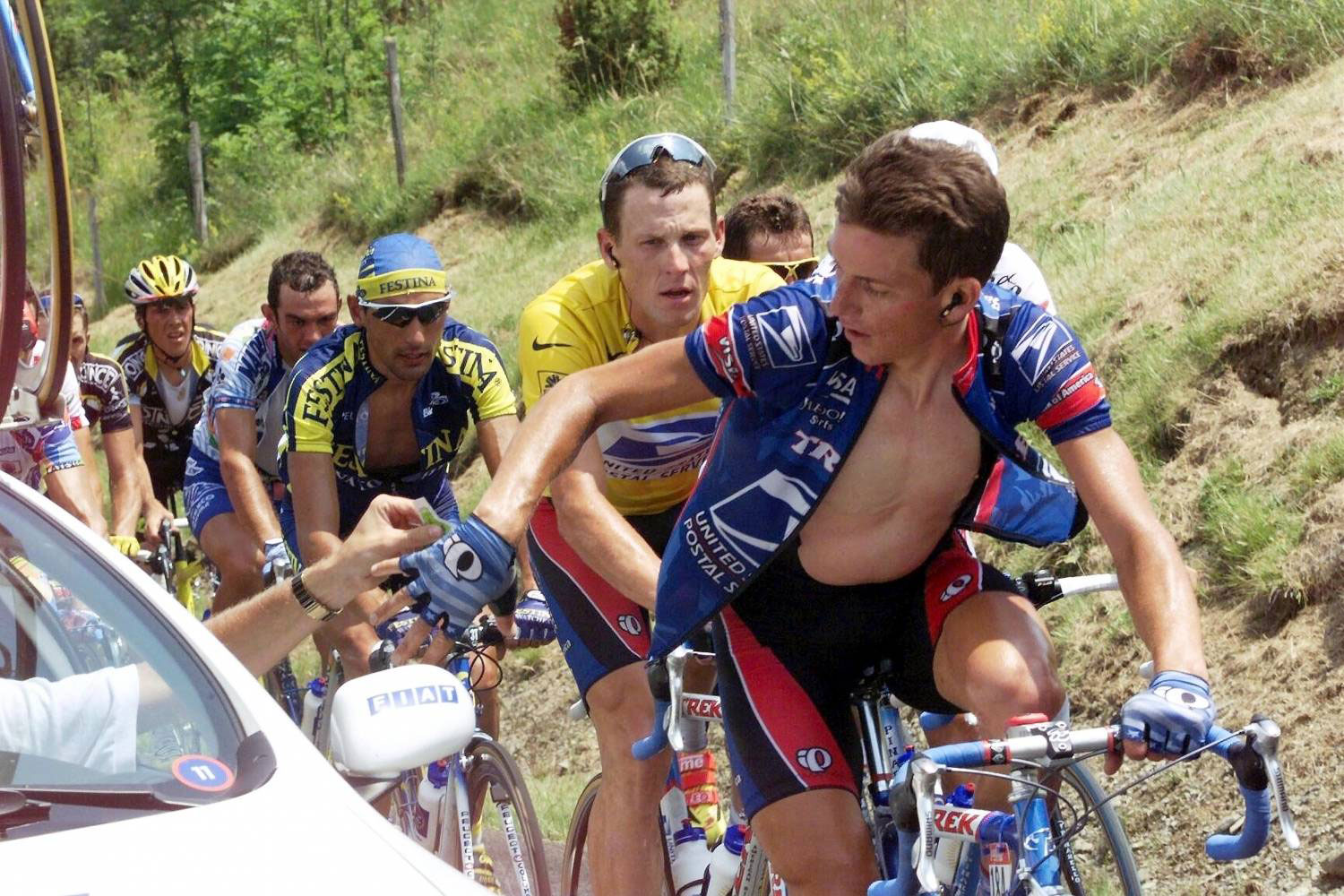Through clouds of dust, bikes can just about be made out, strewn across an unpaved road where bodies lie prone on the cold ground of Northern France. Crashes are a part of professional road cycling, particularly at the famous Paris-Roubaix one-day race, where riders must navigate multiple sections covered in rough terrain and cobblestones. Most of the time, they get up and carry on, dirtied, bloodied. Not for nothing is the race dubbed ‘The Hell of the North’. But the Italian sprinter Matteo Trentin doesn’t get up. He can’t get up, in fact, because he has broken his back.
“I knew it straight away, I felt the crack in my body,” he says now, staring at the beautiful Italian Dolomites where he’s from and often trains, and which form a stunning backdrop for L Chimpl, his favourite restaurant in Vigo di Fassa. “I was riding and suddenly, boom! The bike slipped away from me. I couldn’t do anything, I couldn’t get out of the way. For the seconds I was on the ground I was not only worried my career was over, but that my life would change completely.
“But then I saw I could move my legs so it would probably be ok,” he brightens. “You know… this happens in cycling.” Incredibly, just four months after Trentin suffered a compression fracture of his spine, he is contemplating starting the gruelling Vuelta de Espana later this month with his team Mitchelton-Scott. All 3,271km and 21 days of it, from Malaga to Madrid. It would be quite an undertaking so soon after any serious injury, but a broken back? It feels almost astonishing. Not for Trentin. “I couldn’t even bend forwards to start with, but it’s fine now,” he says matter of factly, in between choosing his favourite dishes for both of us. “I needed to sit on the sofa a bit, and respect the recovery plan, so that when I started training it was the right time.”
Perhaps there’s also a small part of Trentin that feels he has a reputation to maintain. After all, at last year’s Vuelta de Espana this powerfully fast cyclist won a hugely impressive four stages, joining an elite club of riders such as Chris Froome, Mark Cavendish and Eddie Merckx to win stages at all three of the famous Grand Tours; La Vuelta, the Giro D’Italia and the Tour De France. The moment he hit the front on the very last stage in Madrid last year he was in that prized zone so many athletes dream of reaching: complete confidence in his own ability. Almost invincible.
“No, nobody’s invincible,” he counters. “You do have more confidence in yourself of course, and you see the team giving 100 per cent to you, which motivates you to do a little bit more. But at the end of the race only one guy can win, and it’s not always you. We are all at a high level. So it’s a kind of relief when you win, actually. You put yourself under a lot of mental pressure, you concentrate so much in the final 20km that a bee can fly past and you can follow its path exactly. Honestly.”
The bear was alright, but I wasn’t. My helmet was destroyed. But I was pretty worried because you don’t want to be hanging around when there’s a bear loose
 We stop to marvel at Trentin’s favourite dish, typical of the Trentino region, with soft egg, local spinach, cheese, truffles and creamed potatoes given a modern twist by the spectacular Michelin-starred cooking of Stefano Ghetta. Trentin has earned it – he’s already ridden 100km around the mountains this morning – but it’s rich, and I wonder how dining like this matches up with training for a three-week bike race. He passes on the bread, at least.
We stop to marvel at Trentin’s favourite dish, typical of the Trentino region, with soft egg, local spinach, cheese, truffles and creamed potatoes given a modern twist by the spectacular Michelin-starred cooking of Stefano Ghetta. Trentin has earned it – he’s already ridden 100km around the mountains this morning – but it’s rich, and I wonder how dining like this matches up with training for a three-week bike race. He passes on the bread, at least.
“Well, a rider like me doesn’t have to follow a diet to be super skinny because I’m not a climber,” he explains. “But I still need to be careful; too much of anything is never good. It’s about balance and adapting yourself; in a three week Grand Tour you lose weight for the first two weeks because of the aerobic effort and then in the last week you actually gain it because the body goes into protection mode and you start to store water.”
During the races, all the cooking is by the team chefs, which makes for some amusing cultural and culinary differences. As a part of the Belgian team Quick Step Floors for over six years, he came to realise that Belgians are crazy not only for peanut butter but Sirop de Liege.
“I had no idea what it was, some kind of marmalade made from apples, pears and dates, I think,” he laughs. “But it was on every table for every meal. And now I’m with Mitchelton-Scott, an Australian team, they eat tons of coconut butter. Everywhere – in pasta, on bread, in rice. I actually like the taste but not all the time!”
Trentin’s move from Quick Step Floors to Mitchelton-Scott at the end of last season was his first change of team since turning professional in 2010. Quick Step had spotted him as a young hopeful and seen him win a lot of races: “When you see you can win, it becomes addictive,” he says – and eventually gave him a test to see if he could cut it at the highest level. That was when the hard work and the hard miles on the road really started.
“But the level of dedication didn’t surprise me,” he says. “I always say if you are a professional cyclist, you love to cycle. If you don’t have that passion you would never be able to ride six, seven hours, in the rain or in the heat. For example, at the Italian championships this year it was incredibly hot. I got a little heat stroke but several riders passed the finish line and collapsed. When something like that happens you have to have the passion to jump on the bike again the next day.”
Quick Step Floors was the perfect home for Trentin as he was learning his trade. It’s one of cycling’s many nuances that there are professional teams who don’t specialise in riders who win Grand Tours outright – there are no Chris Froome rivals in the Belgian team. But they do consistently win individual stages and one day races – more so than anyone else – and Trentin, who by his own admission “will never contend for a Grand Tour” loved how he had to be at 100 per cent every day to contend for victory.
And in the chaos of a sprint finish, with competing riders reaching speeds of nearly 80km/h, touching wheels and even elbowing each other out of the way, you certainly have to be at your best to win.
“If you watch it on television it looks crazy, and you think that riders must surely crash into each other,” he explains. “But when you are inside the race it’s like everything is like slow motion. For us sprinters it’s like The Matrix. The last kilometre might take only 90 seconds but in my head it’s five minutes, and maybe that’s the same for any fast sport, there’s a slowness of thought you need.”
As for an instinct, for being in the right place at the right time, Trentin muses: “I don’t think so, its more impulse. Instinct suggests you’re not thinking specifically about what you’re doing, but when you’re sprinting for the line, everything is calculated. Put it like this, the focus is wide, but detailed. You see someone moving and you move somewhere else.”
Still, it must be difficult to stick to your team’s plan when the likes of multiple winner Mark Cavendish or world champion Peter Sagan are also making their moves at speed.
“You have to have confidence in your team to get you in the right place, and if something goes wrong with that, you then have to understand who the best person is to follow. This is all happening in a matter of seconds. But you know at the start of the race who is pedalling well, just by looking at them.
Over a remarkable risotto with figs, mushrooms and blue cheese, Trentin tells me of the time he beat Peter Sagan, cycling’s bone fide rock’n’roll star, in a photo finish at the Tour de France in 2014. It meant a great deal to the Italian; he calls Sagan a “one in a million champion, an icon for the sport.” In his house is a framed picture of that photo finish, which Sagan signed. It says a lot about the camaraderie in the sport and the respect they have for one another. Trentin says he often goes out training with the likes of Philippe Gilbert and Filippo Pozzato; opponents in the race but friends off it.
And perhaps, like Sagan, Trentin will be able to count himself as one of cycling’s serial winners in the years to come. He is 29 this month; relatively young in the sport, which made the crash in the Paris-Roubaix race earlier this year so frustrating. After winning in nearly every race he entered towards the end of 2017: “when I started I just couldn’t stop” – the move to Mitchelton-Scott coincided with a definite sense Trentin was not only approaching his sporting prime, but would be leading his new team’s charge for one-day victories and sprint wins at stage races.
You put yourself under a lot of mental pressure, you concentrate so much in the final 20km that a bee can fly past and you can follow its path exactly
Then he crashed into a bear in California. Trentin rolls his eyes.
“I was coming down a hill at 50km/h, and this little bear was eating near a garden,” he laughs. “Some dogs started chasing him, and he ran away the moment I was coming. I clipped his bottom with a pedal and went flying over my handlebars.
“The bear was alright, but I wasn’t. My helmet was destroyed. But I was pretty worried because you don’t want to be hanging around when there’s a bear loose. If he started to howl in pain you can be sure that the mummy grizzly will be along soon. They can run at 50km/hr themselves; you’d have to pedal pretty hard to get away!”
You’d be pretty confident Trentin could do it, of course, but on this occasion he called his girlfriend – former professional Alpine skier Claudia Morandini – and asked her to pick him up. Not before he’d posted about his
experience on Instagram… and swiftly become, as he puts it “the joke of the region.”
It’s this kind of story that makes Trentin so likeable. His home town has a Matteo Trentin fanclub which follows him to races and the owner of L Chimpl, Katia, shows me her collection of signed posters in the office, telling Matteo he’d better win again at La Vuelta so she can put another one up.
“I’d love that,” he smiles. “Between ‘I can do it’ and ‘I will do it’ is a pretty big gap, but I’d love to be back in the winning mood.”


